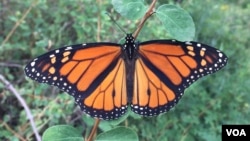A smartphone app lets citizen scientists help professional scientists track changes in the natural world as urbanization, habitat loss, invasive species and climate change shake up ecosystems worldwide.
More than 100,000 users on all seven continents are snapping pictures of plants and animals they find and uploading the images using an app called iNaturalist. Those geotagged photos are giving researchers an unprecedented amount of information about what lives where, and how that's changing with humanity's expanding footprint.
On a spring afternoon in Arlington, Virginia's Barcroft Park, a half-dozen eager onlookers huddle around a plywood board on the forest floor, waiting for the big reveal. Spray-painted on the board are the words, “wildlife study.”
As one volunteer lifts the plywood board, Arlington natural resources manager Alonso Abugattas spots a pair of snakes coiled underneath.
"Northern brown, northern brown," he calls.
Another volunteer leans in with smartphone clicking. He uploads the photos to iNaturalist, where crowdsourcing soon confirms Abugattas' identification.
WATCH: App lets citizen scientists help professional scientists
That observation, tagged by date, time and location, is now part of a growing database of nearly 5 million species finds all over the world.
“Everyone knows that if you want to protect something, you've got to know what you have,” Abugattas said.
Visitors to the iNaturalist website can search an annotated Google map for what lives in their neighborhood. Or search for where others have found a particular species.
As he works to protect Arlington County's natural spaces, Abugattas will be looking for how iNaturalist data gathered on this day-long photo safari compare with earlier surveys.
“Are some things that we had then no longer here? Are some things that we never knew we had now popping back up?” he asks. “That will give us a gauge of how good or how poorly we're doing as far as being stewards.”
Data + excitement
The app came about as a collaboration between biologist and software developer Ken-ichi Ueda and environmental scientist Scott Loarie.
Loarie was studying methods to gather more data for wildlife conservation, while Ueda “was looking for a way to connect people to nature and find ways to use technology to get people excited about the outdoors,” Loarie said.
“That's one of the great things about citizen science. It achieves both those goals,” he said.
And it comes at an important time.
“Species are going extinct at an unprecedented rate,” he said. “We've only begun to understand exactly how those ecosystems contribute to our food system, or human health, all these things that we depend on.”
There's a popular analogy in the field: it's like pulling rivets off the wing of an airplane while it's in flight.
“We don't know exactly which rivet is going to cause the wing to fall off, but it's probably not a good idea to go around popping rivets off the plane,” Loarie said.
Butterflies, snails and mushrooms
So far, iNaturalist data has been a part of studies on monarch butterflies, bats that may carry Ebola, and more.
An iNaturalist user snapped a picture of a rare snail on an island off the coast of Vietnam.
“It's never been collected. It's never been photographed. It's only been drawn. And it was drawn on one of Captain Cook's voyages,” when the 18th-century explorer sailed around the world, Loarie said.
Back in Arlington, the group logged more than 450 species, including some rare plants and the biggest puffball mushroom anyone had seen, as big as a mid-sized dog.
“If you just open up your eyes to the natural world, you'd be amazed at what's out there,” Abugattas said.










